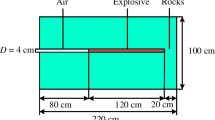Abstract
In this study the effects of the stress path on the hydraulic conductivity characteristics during excavation are analyzed using a 2-D discrete element method. The variation of the stress path of the joints at specific locations (the bottom and wall) and around the periphery of an underground opening have been analyzed. The hydraulic stability of the opening is evaluated using the new concept of the trend distance ratio and trend orientation angle. The results from the analysis of the stress path at the bottom and wall of the opening are as follows: Firstly, most of the stress paths of the joints normal to the excavation surface are within the stable zone, and the hydraulic conductivity of the joints is decreased by 21% in average. Secondly, all of the stress paths of the joints parallel to the excavation surface are within the unstable zone, and the hydraulic conductivity is increased to 2.2 times in average. And the variation of the stress path and hydraulic conductivity is further analyzed for those joints having various distances from the opening. The joints parallel to the excavation surface showed the normal stress decreased by 38% and the hydraulic conductivity increased up to 1.9 times in average. This study makes it possible to determine the hydraulic stability of the underground opening excavated in a jointed rock mass.
Similar content being viewed by others
References
Bae, S.-H. (2005). Characteristics of initial rock stress state in Korean tectonic provinces by hydraulic fracturing stress measurement, Ph. D. Thesis, Seoul National University, Korea, pp. 209.
Bandis, S. (1980). Experimental studies of scale effects on shear strength, and deformation of rock joints, Ph.D. Thesis, The University of Leeds, Department of Earth Sciences, Leeds LS2 9JT, England, pp. 354.
Barton, N. (1982). Modelling rock joint behavior from in situ block tests, Implications for nuclear waste respository design, Office of Nuclear Waste Isolation, Columbus, OH,ONWI-308.
Barton, N. and Bandis, S. (1990). “Review of predictive capabilites of JRC-JCS model in engineering practice” In rock joints, proc. International Symposium on Rock Joints, Loen, Norway, Rotterdam: Balkema, pp. 603–610, DOI: 10.1016/0148-9062(91)90682-C.
Barton, N., Bandis, S., and Bakhtar, K. (1985). “Strength, deformation and conductivity coupling of rock joints.” Int. J. Rock Mech. Min. Sci. & Geomech., Abstr., Vol. 22, No. 3, pp. 121–140, DOI: 10.1016/0148-9062(85)93227-9.
Itasca Consulting Group, Inc., (2004). UDEC -Universal Distinct Element Code, Ver. 4.0, Special Features manual, Minneapolis, Minnesota.
Itasca Consulting Group, Inc., (2004). UDEC -Universal Distinct Element Code, Ver. 4.0, Theory and Background manual, Minneapolis, Minnesota.
Ko, T.-Y. and Moon, H.-K. (2001). “A study on the groundwater flow in three-dimensional networks of discrete joints.” The Korean Society of Mineral and Energy Resources Engineers, Vol. 38, No. 3, pp. 178–187.
Lee, Y.-S., Lee, S.-D., Park, K.-H., Joo, K.-S., and Moon, H.-K. (2003). “A study on the hydro-mechanical behavior of jointed rock masses around underground excavation by using a discrete joint network modeling.” The Korean Society of Mineral and Energy Resources Engineers, Vol. 40, No. 6, pp. 457–466.
Lim, S.-B. and Moon, H.-K. (2011). “The stress path of the rock mass due to the advance of 3-D underground excavation and support.” The Korean Society of Mineral and Energy Resources Engineers, Vol. 48, No. 1, pp. 67–78.
Olsson, R. and Barton, N. (2001). “An improved model for hydromechanical coupling during shearing of rock joints.” International Jounal of Rock Mechanics & Mining Sciences, Vol. 38, No. 3, pp. 317–329, DOI: 10.1016/S1365-1609(00)00079-4.
Seo, Y.-B. and Moon, H.-K. (2010). “A numerical study on the stresspath of the rock mass around an underground excavation.” The Korean Society of Mineral and Energy Resources Engineers, Vol. 47, No. 1, pp. 61–69.
Son, M. (2012). “The effects of stress paths due to underground excavation on the hydraulic conductivity characteristics of jointed rock mass.” M.S. Thesis, Hanyang University, Korea, pp. 71.
Song, M.-G. (1993). “A numerical study on hydraulic conductivity of jointed rock masses and fluid flow in rock joints.” M.S. Thesis, Hanyang University, Korea, pp. 66.
Author information
Authors and Affiliations
Corresponding author
Rights and permissions
About this article
Cite this article
Son, M., Moon, HK. The hydraulic stability assessment of jointed rock mass by analysis of stress path due to underground excavation. KSCE J Civ Eng 21, 2450–2458 (2017). https://doi.org/10.1007/s12205-016-1017-0
Received:
Accepted:
Published:
Issue Date:
DOI: https://doi.org/10.1007/s12205-016-1017-0




